Offshore Oil
-
- U.S. COULD LEARN A LESSON FROM GREAT BRITAIN'S OFFSHORE OIL LEASING Maritime Reporter, Jun 1985 #65
The current "oil glut" and the oversupply of natural gas have lulled Americans into a false sense of energy security. If something is not done to speed up the pace of domestic energy exploration and production, we will find ourselves more dangerously dependent on foreign energy suppliers in the not-toodistant future.
We have the capability to become energy independent by developing this nation's Outer Continental Shelf (OCS). The OCS is estimated to contain as much as 44 billion barrels of oil and 231 trillion cubic feet of natural gas.
But offshore energy is not a spigot that can be turned on at will. It takes an average of seven years from the time exploration starts until production of oil and gas can begin.
This means that we should be looking today for the energy that our nation will need in 1992. Yet America's development of its OCS has been slow and relatively unsuccessful in comparison with other countries.
Take Great Britain, for example.
Until the mid-1960s, Great Britain imported virtually all of its oil and gas. However, after implementing a major licensing program to open the North Sea to exploration and production, Britain has moved from total dependence on foreign imports to independence. In less than 20 years, it has become a net exporter and the world's fifth largest oil producer.
The United States, on the other hand, currently imports about onethird of the oil it consumes. We can expect foreign imports to increase significantly unless new domestic supplies are found soon.
The U.S. took an important step toward energy independence in 1982 by implementing a concept that Great Britain has used very successfully for many years—areawide leasing. The Department of the Interior adopted this approach when they created the present five-year plan to expedite exploration and development of the OCS. For 28 years prior to that, offshore lands had been offered for lease under a "nomination" system, in which the federal government offered a limited number of specific tracts for leasing based on their geological prospects.
Since its inception, the five-year areawide leasing program has been a subject of intense controversy, attracting both strong support and severe criticism. Hoping to resolve some of the conflict, Interior Secretary Donald Hodel recently issued the first draft proposal of a new five-year program that reduced the pace of leasing activities and changed the original concept of areawide leasing.
It is unfortunate that the Department of the Interior feels compelled to take this action, because Great Britain's track record proves that the areawide approach works. While the U.S. "nomination" leasing program was in effect between 1954 and 1982, only 4 percent of the nearly 1-billion-acre OCS was offered for lease, and only 22 million acres were actually leased.
In the first two rounds of Great Britain's offshore program in 1964 and 1965, however, 113 million acres were offered and nearly 27 million acres were licensed (the British government grants licenses to explore and develop rather than leasing tracts). In just those two years, Great Britain licensed more acreage than the U.S. leased in 28 years.
And in 16 years, the British government licensed nearly 58 million acres, more than twice what would have been offered for lease under the original U.S. five-year plan.
The result of licensing this acreage has been a steady increase in British offshore exploration and production. By 1982, Great Britain was producing an average of more than 2 million barrels of oil daily, nearly twice the daily average offshore production of the United States, which was in decline. The U.S., in fact, was the only nation in the world whose offshore oil production decreased during the 1970s.
The advent of areawide leasing was a shot in the arm for America's ailing offshore industry—at least judging by rig activity in the Gulf of Mexico, a recognized indicator of oil industry health. After bottoming out in mid-1983, the rig utilization rate rose sharply as a direct result of the attractive prospects offered in areawide lease sales.
Instead of making leasing more difficult and restrictive, the federal government should take a clue from the British and remove some of the obstacles hindering OCS development.
We will then have a better chance to reduce our dependence on foreign oil and help insure the nation's energy future.
R. Nelson Crews, president and chief operating officer of Raymond International, Inc. of Houston, Texas, was elected chairman of the National Ocean Industries Association (NOIA) in April 1985. NOIA serves as the legislative and administrative spokesman for the nation's offshore and ocean-related industries.
Its more than 450 companies include offshore drilling contractors, supply boat operators, diving crews, geophysical companies and many other kinds of business involved in ocean and marine-related development.
-
- Newfoundland's Ocean Cargo Services Seen Expanding With Coming Offshore Oil Boom Maritime Reporter, Dec 15, 1981 #24
Newfoundland's c o m i n g offshore oil boom will trigger a parallel growth in the province's maritime and air transportation services, the Hon. Neil Windsor, Newfoundland's minister of development, recently told members of the Executives Club of Chicago. Already two o c e a n c a r r i e rs serving
-
- NRC Releases Study Assessing The Safety Of OCS Offshore Oil Maritime Reporter, Nov 1981 #37
The National Academy of Engineering recently released its study of "Safety and Offshore Oil." This document was commissioned by the U.S. Geological Survey and the U.S. Coast Guard in response to a provision of the OCS Lands Act Amendments of 1978. In June, 1979, the Geological Survey requested
-
- $400 Million To Be Spent On Newfoundland Offshore Oil Drilling This Year Maritime Reporter, Aug 1981 #35
cover only one-eighth of our continental shelf which covers 730,000 square miles." The Newfoundland Government official said that offshore oil was but one of the developments which "has placed Newfoundland on the threshold of major social and economic change over the next 10 years
-
- CANADA'S EAST COAST OFFSHORE OIL POTENTIALOPPORTUNITIES FOR SHIPBUILDING Maritime Reporter, Jun 1981 #52
Mobil Oil Canada, Ltd., has been active in the eastern Canadian offshore exploration drilling since 1967, principally in the vicinity of Sable Island and on the Eastern Grand Banks. In the early 1970s, these exploration drilling activities led to involvement with the Canadian shipbuilding industry.
-
- Enclosed Lifeboats Serve As Escape Craft For Offshore Oil Platforms Maritime Reporter, Apr 15, 1981 #17
Watercraft America, Inc., located in Edgewater, Fla., is designing and building ad- vanced lifeboats and launch systems for installation on offshore drilling and production platforms and ships. Called the Watercraft Survival System, it includes a series of lifeboats, winches, and davits that
-
- Report On Domestic Offshore Oil Published Maritime Reporter, Feb 15, 1981 #8
Record levels of U.S. coastal energy development will result from higher world petroleum prices, domestic deregulation and an a m b i t i o u s offshore leasing program among other factors, according to the just published second edition of the special report by TransTech Co. (marine consultants) entitl
-
- U.S. Firms Share In New U.K. Licenses For Offshore Oil Maritime Reporter, Mar 1977 #36
Great Britain's energy minister, Tony Wedgwood Benn, has announced the conditional award of offshore oil production licenses for 44 blocks to 65 oil companies. The offshore blocks are in the seas on all sides of Britain. They involve approximately 18,000 square miles in the North Sea, Irish Sea
-
- Congressman Murphy To Address Offshore Oil Conference Maritime Reporter, Aug 15, 1978 #45
M. Murphy, Chairman of the House ad hoc Select Committee on The Outer Continental Shelf, will keynote its national two-day conference on offshore oil. Entitled "Offshore Oil: Challenge And Change," the conference will be held on November 2 and 3 at The Hyatt Regency Hotel in Dallas, Texas. This
-
- New England Company Receives U.S. Funds To Investigate Giant Sphere As Offshore Oil Terminal Maritime Reporter, Nov 15, 1977 #46
Nashua, N.H., was awarded a grant by the Energy Research and Development Administration (ERDA) to test the feasibility of Tuned Spheres in the role of offshore terminal facilities. Tuned Sphere International, headquartered in Nashua, N.H., is a subsidiary of Energy Systems Corporation, the parent organization
-
- SNAME Philadelphia Section Discusses The Why And How Of Offshore Oil/Gas Drilling Maritime Reporter, Apr 1976 #48
was attended by 65 members and guests. Following a social hour and dinner, S.T. Hudson, president, J.E. Brenneman Co., presented a paper entitled "Offshore Drilling." The paper discusses the why and how of offshore drilling for oil and gas. Further, it describes drilling operations and production. The
-
- First Offshore Oil Discovery Made In Canadian Arctic Sea Maritime Reporter, Apr 1974 #42
Sea of the Canadian Arctic. The company said it has a threezone oil and gas discovery from a drilling platform on a temporary artificial island offshore from the Mackenzie Delta area. It is about 300 miles east-southeast of the major oil fields at Prudhoe Bay, Alaska. Imperial did not disclose
-
 )
March 2024 - Marine Technology Reporter page: 45
)
March 2024 - Marine Technology Reporter page: 45ronments. The new agreement will address speci? c techni- cal gaps in the UUV defense and offshore energy markets especially for long duration, multi-payload mission opera- tions where communications are often denied or restricted. As part of the new alliance, Metron’s Resilient Mission Autonomy portfolio
-
 )
March 2024 - Marine Technology Reporter page: 43
)
March 2024 - Marine Technology Reporter page: 43mega-booth at Oi, busy start to ? nish. Image courtesy Greg Trauthwein offers quality sub-bottom pro? ling capability without the need tion of offshore windfarms. GeoPulse 2 introduces new capa- for any dedicated transducers or cabinet of electronics. That bilities that enhance both its operation
-
 )
March 2024 - Marine Technology Reporter page: 42
)
March 2024 - Marine Technology Reporter page: 42NEW TECH OCEANOLOGY INTERNATIONAL 2024 Image courtesy Greg Trauthwein Image courtesy BIRNS MacArtney launches the new ultra-compact ø12.7 mm SubConn Nano connector. Innovative connectivity built on 45 years of ? eld-proven and market-trusted design. Image courtesy MacArtney Birns celebrated its 70th
-
 )
March 2024 - Marine Technology Reporter page: 39
)
March 2024 - Marine Technology Reporter page: 39Photo courtesy Global Ocean Design Figure 7 A 35Ah AGM lead-acid battery is tested using the West Mountain Radio CBA to show the effect of simply ? lling the battery voids with mineral oil as a compensating ? uid. The CBA is programmed to cut-off at a voltage of 10.50v. The top line (red) shows the
-
 )
March 2024 - Marine Technology Reporter page: 36
)
March 2024 - Marine Technology Reporter page: 36LANDER LAB #10 Of special interest for marine applications, LiPo batteries are Shipping any kind of lithium battery can be a challenge, and offered in a “pouch” design, with a soft, ? at body. The pouch IATA regs vary with the batteries inside or outside an instru- is vacuum-sealed, with all voids ?
-
 )
March 2024 - Marine Technology Reporter page: 35
)
March 2024 - Marine Technology Reporter page: 35Figure 1 A self-righting vehicle design with buoyancy high and weight low, WHOI’s SeaBED AUV captures the attention of a pair of curious Antarctic penguins as it is deployed from the British research vessel James Clark Ross. Vehicle designers allowed for temperature reduction of battery capacity. Recharge
-
 )
March 2024 - Marine Technology Reporter page: 33
)
March 2024 - Marine Technology Reporter page: 33regulated industry in the world.” How- ever, commercial success depends on many factors, not least a predictable OPEX. Over the past four years, SMD has worked with Oil States Industries to calculate cost per tonne ? gures for prospective customers. Patania II uses jet water pumps to Oil States’
-
 )
March 2024 - Marine Technology Reporter page: 20
)
March 2024 - Marine Technology Reporter page: 20Calendar January/Februay 2024 February 2024 March/April 2024 Ad close Jan.31 Ad close March 21 Ad close Feb. 4 Underwater Vehicle Annual Offshore Energy Digital Edition ?2?VKRUH:LQG$)ORDWLQJ)XWXUH ?2FHDQRJUDSKLF?QVWUXPHQWDWLRQ 6HQVRUV ?6XEVHD'HIHQVH ?6XEVHD'HIHQVH7KH+XQWIRU ?0DQLSXODWRU$UPV 7RRO
-
 )
March 2024 - Marine Technology Reporter page: 18
)
March 2024 - Marine Technology Reporter page: 18with stab surveys or dual TSS440) as the signals from the tracker do not affect the sen- cell ? eld gradient surveys. sor readings. This feature reduces offshore time as a pre-sur- Images courtesy FORCE Technology New version of FiGS in the inspection arm. 18 MTR #3 (18-33).indd 18 4/4/2024 8:59:50 A
-
 )
March 2024 - Marine Technology Reporter page: 16
)
March 2024 - Marine Technology Reporter page: 16and struc- replacements, which also aligns well with sustainable opera- tures from corrosion, is relatively straightforward. tional practices in the offshore industry. However, in order to Made of alloys like aluminum, Zinc and is some protect underwater assets effectively, the condition of CP an- T cases
-
 )
March 2024 - Marine Technology Reporter page: 14
)
March 2024 - Marine Technology Reporter page: 14speed of up to 3 knots. need for environmental monitoring, especially to track the “The Sentinel is the world’s fastest glider – its buoyancy impact of offshore construction on the ocean ecosystem, the engine is large enough to deal with large density changes in Sentinel can accommodate a greater number
-
 )
March 2024 - Marine Technology Reporter page: 4
)
March 2024 - Marine Technology Reporter page: 4of the Contributing Writers Kevin Hardy number of team members sent to speci? c events.. Celia Konowe We have media serving the global maritime, subsea, offshore energy, ports and logistics Edward Lundquist David Strachan markets, which in this context means that we attend a lot of exhibitions and conferences
-
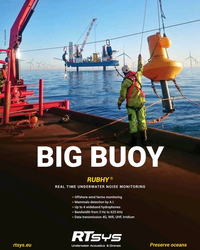 )
March 2024 - Marine Technology Reporter page: 1
)
March 2024 - Marine Technology Reporter page: 1Photo: Georgina Kelly BIG BUOY ® RUBHY REAL TIME UNDERWATER NOISE MONITORING > Offshore wind farms monitoring > Mammals detection by A.I. > Up to 4 wideband hydrophones > Bandwidth from 3 Hz to 625 kHz > (EXEXVERWQMWWMSR+;M?9,*-VVMHMYQ rtsys.eu Preserve oceans MTR #3 (1-17).indd 1 4/4/2024 8:47:57
-
 )
April 2024 - Maritime Reporter and Engineering News page: 47
)
April 2024 - Maritime Reporter and Engineering News page: 47in ReducO on Chamber (206) 286-1817 www.merequipment.com QUALITY NACOL ACCUMULATORS • Forged shells, no welds • Long LasO ng, No Seam, Pleated Bladders OFFSHORE WIND • We stock 1/5 pint to 15 gallons in Chicago Log on to the • Sizes available to 40 gallons MARKET INTELLIGENCE MarineLink.com Intelatus offers
-
 )
April 2024 - Maritime Reporter and Engineering News page: 41
)
April 2024 - Maritime Reporter and Engineering News page: 41solutions speci? cally designed for use in harsh maritime environments: • GMDSS/NAVTEX/NAVDAT coastal surveillance and transmission systems • Offshore NDB non-directional radio beacon systems for oil platform, support vessel & wind farm applications • DGPS coastal differential global positioning
-
 )
April 2024 - Maritime Reporter and Engineering News page: 38
)
April 2024 - Maritime Reporter and Engineering News page: 38. the world's ? rst zero-emissions mooring service for a tanker. Equipped with two 150 kW engines and a lithium battery ca- This took place at an offshore multiple buoy mooring site near pacity of 485 kWh, Castalia ensures operational autonomy of the BP re? nery, two miles from the Port of Castellón
-
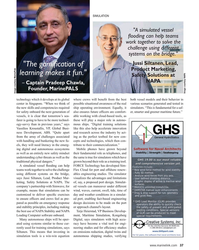 )
April 2024 - Maritime Reporter and Engineering News page: 37
)
April 2024 - Maritime Reporter and Engineering News page: 37tool. A simulated vessel ? ooding can help FORCE Technology has developed Sim- teams work together to solve the challenge Flex Cloud for port and offshore renew- using different systems on the bridge, ables engineering studies. The simulator says Jussi Siltanen, Lead, Product Mar- visualizes the advantages
-
 )
April 2024 - Maritime Reporter and Engineering News page: 35
)
April 2024 - Maritime Reporter and Engineering News page: 35certi? cation from ClassNK for Japan’s today is just eight seconds, one second less than gold? sh. The ? rst training program for crew members of offshore wind in- science behind these attention span perceptions is limited, but dustry crew transfer vessels (CTVs). The training uses the lat- educators
-
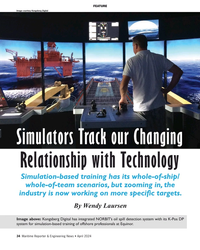 )
April 2024 - Maritime Reporter and Engineering News page: 34
)
April 2024 - Maritime Reporter and Engineering News page: 34Wendy Laursen Image above: Kongsberg Digital has integrated NORBIT’s oil spill detection system with its K-Pos DP system for simulation-based training of offshore professionals at Equinor. 34 Maritime Reporter & Engineering News • April 2024 MR #4 (34-44).indd 34 4/5/2024 8:43:52 A
-
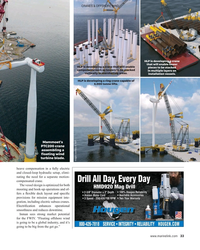 )
April 2024 - Maritime Reporter and Engineering News page: 33
)
April 2024 - Maritime Reporter and Engineering News page: 33CRANES & OFFSHORE WIND HLP is developing a crane that will enable tower HLP is developing a crane that will enable pieces to be stacked components such as towers to be stacked in multiple layers on vertically in marshalling areas. installation vessels. HLP is developing a ring crane capable of 6
-
 )
April 2024 - Maritime Reporter and Engineering News page: 32
)
April 2024 - Maritime Reporter and Engineering News page: 32of Mammoet requirement for the development of these cranes, particularly ling area. This would result in a major time and fuel saving. in ? oating offshore wind,” says Adrian Green, Engineering & For ? oating projects, it could reduce project installation time Contracts Director. “Ports are a major
-
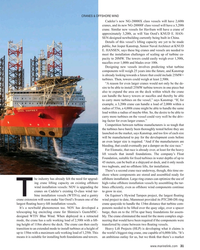 )
April 2024 - Maritime Reporter and Engineering News page: 31
)
April 2024 - Maritime Reporter and Engineering News page: 31CRANES & OFFSHORE WIND Cadeler’s new NG-20000X class vessels will have 2,600t cranes, and its new NG-20000F class vessel will have a 3,200t crane. Similar new vessels for Havfram will have a crane of approximately 3,200t, as will Van Oord’s KNUD E. HAN- SEN-designed newbuilding currently being built in
-
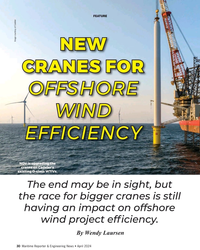 )
April 2024 - Maritime Reporter and Engineering News page: 30
)
April 2024 - Maritime Reporter and Engineering News page: 30FEATURE Image courtesy of Cadeler NEW CRANES FOR OFFSHORE WIND EFFICIENCY NOV is upgrading the cranes on Cadeler’s existing O-class WTIVs. The end may be in sight, but the race for bigger cranes is still having an impact on offshore wind project ef? ciency. By Wendy Laursen 30 Maritime Reporter
-
 )
April 2024 - Maritime Reporter and Engineering News page: 28
)
April 2024 - Maritime Reporter and Engineering News page: 28, we have ten container and roll on/roll off ships, two expeditionary transfer docks (ESDs) and four expeditionary sea base ships. We also have two offshore petro- leum distribution system ships that help move fuel ashore. Another ten preposition ships support the Army and Air Force. It should be pointed
